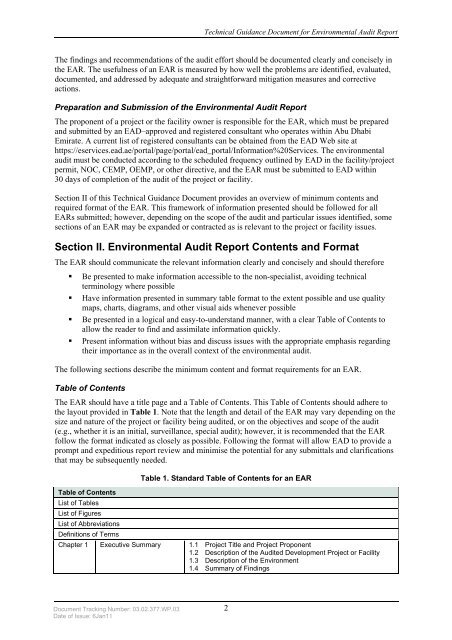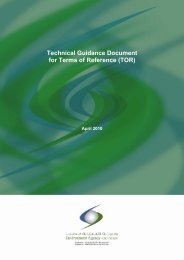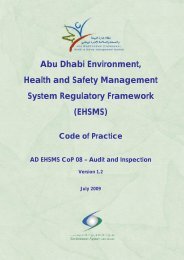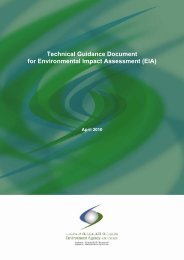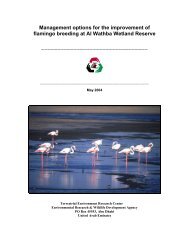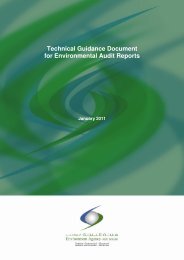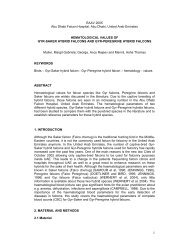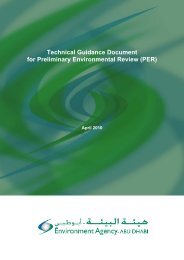Technical Guidance Document for Environmental Audit Reports
Technical Guidance Document for Environmental Audit Reports
Technical Guidance Document for Environmental Audit Reports
You also want an ePaper? Increase the reach of your titles
YUMPU automatically turns print PDFs into web optimized ePapers that Google loves.
<strong>Technical</strong> <strong>Guidance</strong> <strong>Document</strong> <strong>for</strong> <strong>Environmental</strong> <strong>Audit</strong> Report<br />
The findings and recommendations of the audit ef<strong>for</strong>t should be documented clearly and concisely in<br />
the EAR. The usefulness of an EAR is measured by how well the problems are identified, evaluated,<br />
documented, and addressed by adequate and straight<strong>for</strong>ward mitigation measures and corrective<br />
actions.<br />
Preparation and Submission of the <strong>Environmental</strong> <strong>Audit</strong> Report<br />
The proponent of a project or the facility owner is responsible <strong>for</strong> the EAR, which must be prepared<br />
and submitted by an EAD–approved and registered consultant who operates within Abu Dhabi<br />
Emirate. A current list of registered consultants can be obtained from the EAD Web site at<br />
https://eservices.ead.ae/portal/page/portal/ead_portal/In<strong>for</strong>mation%20Services. The environmental<br />
audit must be conducted according to the scheduled frequency outlined by EAD in the facility/project<br />
permit, NOC, CEMP, OEMP, or other directive, and the EAR must be submitted to EAD within<br />
30 days of completion of the audit of the project or facility.<br />
Section II of this <strong>Technical</strong> <strong>Guidance</strong> <strong>Document</strong> provides an overview of minimum contents and<br />
required <strong>for</strong>mat of the EAR. This framework of in<strong>for</strong>mation presented should be followed <strong>for</strong> all<br />
EARs submitted; however, depending on the scope of the audit and particular issues identified, some<br />
sections of an EAR may be expanded or contracted as is relevant to the project or facility issues.<br />
Section II. <strong>Environmental</strong> <strong>Audit</strong> Report Contents and Format<br />
The EAR should communicate the relevant in<strong>for</strong>mation clearly and concisely and should there<strong>for</strong>e<br />
• Be presented to make in<strong>for</strong>mation accessible to the non-specialist, avoiding technical<br />
terminology where possible<br />
• Have in<strong>for</strong>mation presented in summary table <strong>for</strong>mat to the extent possible and use quality<br />
maps, charts, diagrams, and other visual aids whenever possible<br />
• Be presented in a logical and easy-to-understand manner, with a clear Table of Contents to<br />
allow the reader to find and assimilate in<strong>for</strong>mation quickly.<br />
• Present in<strong>for</strong>mation without bias and discuss issues with the appropriate emphasis regarding<br />
their importance as in the overall context of the environmental audit.<br />
The following sections describe the minimum content and <strong>for</strong>mat requirements <strong>for</strong> an EAR.<br />
Table of Contents<br />
The EAR should have a title page and a Table of Contents. This Table of Contents should adhere to<br />
the layout provided in Table 1. Note that the length and detail of the EAR may vary depending on the<br />
size and nature of the project or facility being audited, or on the objectives and scope of the audit<br />
(e.g., whether it is an initial, surveillance, special audit); however, it is recommended that the EAR<br />
follow the <strong>for</strong>mat indicated as closely as possible. Following the <strong>for</strong>mat will allow EAD to provide a<br />
prompt and expeditious report review and minimise the potential <strong>for</strong> any submittals and clarifications<br />
that may be subsequently needed.<br />
Table 1. Standard Table of Contents <strong>for</strong> an EAR<br />
Table of Contents<br />
List of Tables<br />
List of Figures<br />
List of Abbreviations<br />
Definitions of Terms<br />
Chapter 1 Executive Summary 1.1 Project Title and Project Proponent<br />
1.2 Description of the <strong>Audit</strong>ed Development Project or Facility<br />
1.3 Description of the Environment<br />
1.4 Summary of Findings<br />
<strong>Document</strong> Tracking Number: 03.02.377.WP.03<br />
Date of Issue: 6Jan11<br />
2


